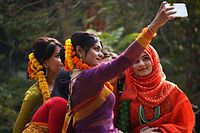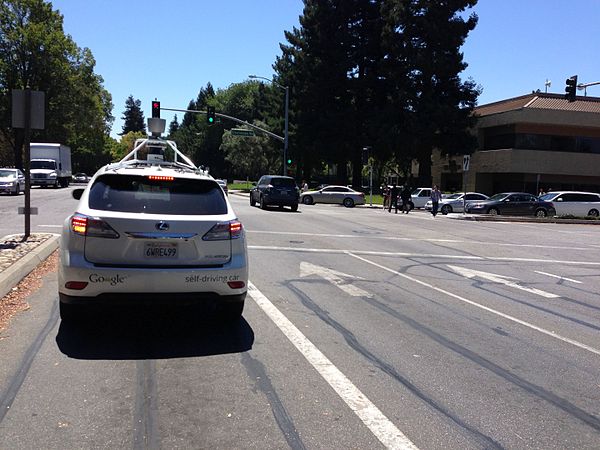ICT student textbook/Introduction
What is ICT
Have you even seen something like this? Can you tell what the girls are doing?
They are using a mobile phone to take a photo of themselves. Is there anything different about how they are doing this? Have you ever seen anyone in your school or community or home use a phone? Can you describe the things you have seen then do with a phone?
Look at this machine here - have you have seen something like this anywhere in your neighbourhood? Have you seen anyone use a machine like this? This is an ATM machine from which you can get cash. Usually it will have the name of some bank written on the sign, example State Bank ATM.
Are you thinking what is common between these two pictures? Let us find out.
Think and write
Look at the table below and complete it. In the last column make a list of equipment and facilities you think you need for doing these things.
|
Look at the list below and underline if if you have done or seen or heard of these things
|
Compare the list you have made with your friends. What did you find? You may also now be starting to wonder how these things are done. There is one thing that is common across all these things - which makes these different things possible - the use of Information Communication Technologies, ICT.
Before we understand what are ICT, look at the list below and circle all the words that you have heard of: File:Have you heard of ICT terms.mm (If you are using the printed book, please open the file "Have_you_heard_of_ICT_terms.mm" using Freeplane).
As students, you may have been introduced to some or many of these terms in your school, in your family or in your neighbourhood. The cell phone tower, your nearest ATM, your mother's mobile phone, games, whatsapp chats, email, the selfie, internet, videos and songs on your computer - all these are examples of a new kind of ICT. These technologies are called digital technologies and they are changing the way we talk to each other, work with each other, and the way we do things. The computer is becoming like a television, the phone is becoming like a computer, you can use the computer to make voice calls, you can record a video with your phone, you can read your newspaper on the phone, and you can even paint with your computer! The technologies that make all these possible are collectively called ICT.
ICT refers to those set of technologies that help us create information, access information, analyze information and communicate with each other. Human beings have always accessed information and communicated, but what makes these present technologies special is their digital nature. You can read more about how ICT developed in the chapter on Science, Technology and Society.
We live in an information society
Look at the pictures below and discuss with your friends and teacher.
| What is this bonobo doing - can you guess? You are correct! It is "fishing" for termites from an ant hill.
| |
| What is special about this car? Did you guess? What is the meaning of self-driving car? Yes, it has no driver.
|
Today's society is called the information society. To see why, let us think of a small activity.
Think and write
Let us say you are withdrawing money from a nearby ATM. Can you make a list of all the things you need to do for that? You need your account number, your Personal Identification Number (PIN) and you need to enter the amount of money. When you put your card in the machine, it verifies your PIN, collects information about your bank account, the bank and the balance amount. The ATM machine does all of this, communicates with your bank and allows you to withdraw the money.
In the box below, can you list down three important words that come to your mind when you read about this? Can you draw a flowchart of how you think this activity could happen?
|
|
So many things we do now are based on collecting information, processing information, representing information and communicating information. Many devices - mobile phones, television, computers, tablets, cameras, scanners, collectively called ICT, have made this possible. How we collect information, how we analyze it, how we communicate the information and how we use the information to make decisions are all very important. ICT and broadly digital technologies are changing the way we do things, thus making today's society an information society. You may be familiar with the computer but now ICT have moved far beyond the computer alone. As students you have to learn ICT to build your skills for functioning in the information society.
What can you expect to learn
ICT can help you create music, write poetry, learn mathematics or make videos. ICT can also help you in communicating with each other and learning together. This textbook has been developed to introduce you to all these possibilities.
In this new subject called ICT, we can expect to learn about ICT and how to work with ICT; this will be covered over a 3 year period.
Knowledge based
This subject will introduce you to:
- What is ICT
- How did ICT develop
- Effect ICT has on family, neighbourhood, school and village
- Use of ICT ethically, safely and responsibly
Skill
In this subject, through different hands-on activities and projects you will learn to:
- Use ICT to express your ideas, using available resources (using images, audio, text, videos)
- Use ICT to learn school subjects and improve your general knowledge
- Use ICT to talk to your friends, to work together and to play together
- Use ICT to help in the development of the local community, socio cultural activities and development.
As students, you are encouraged to explore this new area and make connections to your own daily life, the impact these ICT have on your life, how you would like to work with this technology and how you can equip yourself to understand this new way of thinking, learning and communicating.
How is this book organized
The textbook will have 5 units:
- What is the nature of ICT
- Data representation and processing
- Communication with graphics
- Audio visual communication
- Learn your school subjects
- Each unit has a brief introduction followed by hands-on activities for each unit. Each of the units will have activities at three different levels, as you move from class 6-8. Different ICT devices, tools and applications will be used for the activities. Your teacher will show you how to use an ICT device or application. Instructions for learning an application are available here.
- Your teacher will determine the appropriate level of activity. She will introduce a new unit or an activity with a demonstration. This will be followed by activities for you. These activities could include some projects and will involve individual or group work.
- You can work individually or in groups or read the textbook and discuss in the classroom. Different groups in the class will work on different examples for a given theme and share your analysis, findings and creations. You will learn together and teach one another!




